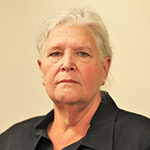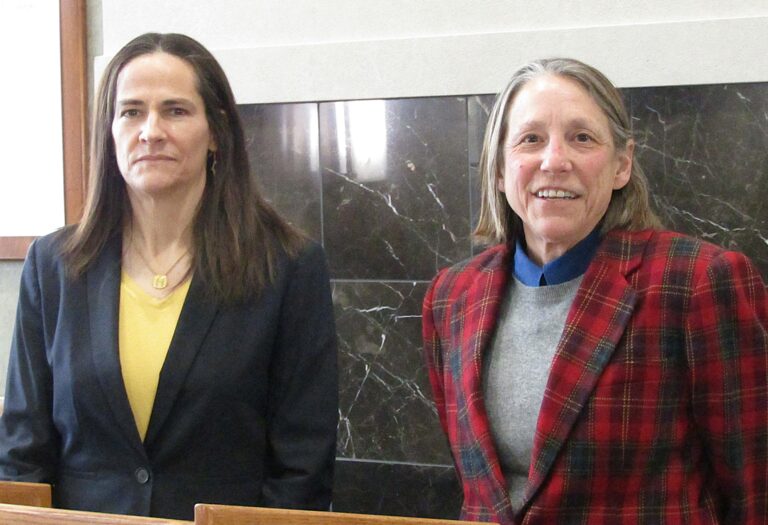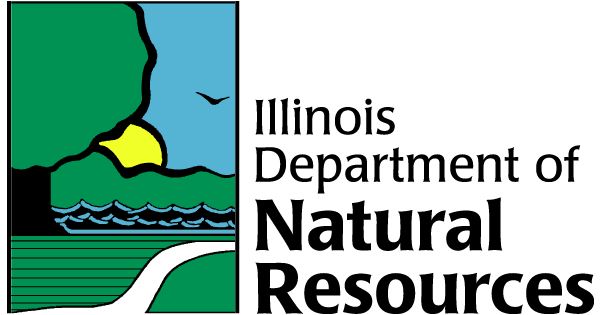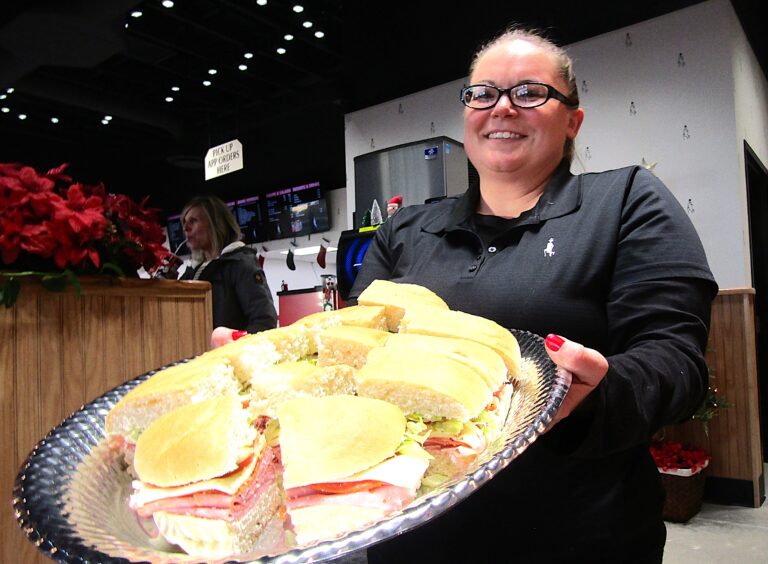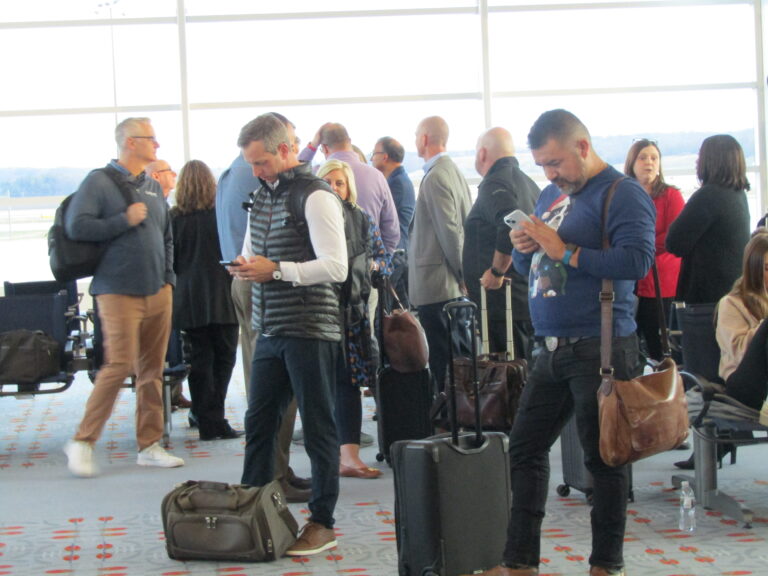Find your passion, don’t be afraid to pivot, and go climb a tree were among the words of wisdom shared with 125 area high school and college students on Thursday, Oct. 17, at the River Action Upper Mississippi River Conference at Western Illinois University in Moline.
This year’s “Learning From Each Other” themed conference at the WIU Mississippi Riverfront campus featured for the first time in its 18-year history a Next Gen Summit.
It brought together student leaders and experts in environmental science-related fields who urged the students crammed into the Building C Atrium to begin to prepare for rewarding careers in environmental fields.
The leaders who shared their paths to careers in the environmental sciences were:
- Megan Tarasi is a sustainability analyst who helps support the ambitious sustainability goals set by HNI Corp. by providing data analysis and reporting on greenhouse emissions.
- Bob Bohannon is the retired water plant manager for the City of Moline.
- Andrew Layer is programs manager for Living Lands & Waters in East Moline.
- Janet Meshek is principal engineer at Meshek & Associates. She also led the “Flooding Fundamentals” panel where she outlined the dramatic changes made in Tulsa, Oklahoma, after frequent flooding of the Arkansas River.
- David Greenwood-Sanchez, assistant professor of Political Science at the University of Iowa. His research examines the connection between politics and international relations as it centers on food, agriculture and global trade.
- Lorraine Foelske is a natural areas preservation specialist at the Illinois Department of Natural Resources. She covers preserves in nine counties in Illinois including Rock Island County.
- Ray Wolf, retired science and operations officer, National Oceanic and Atmospheric Administration (NOAA), National Weather Service, in Davenport. In addition to talking to young people about careers in climatology and forecasting, he also was part of the conference’s Communicating Climate Change panel.
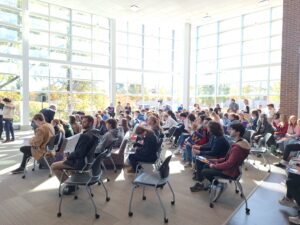
Career paths varied
In addition to a keen interest in the environment, these panelists also had this in common: They came to their current jobs from very different paths than the one they set out on.
Ms. Tarasi said of her job at Muscatine, Iowa-based HNI, “My road there was definitely not a straight path. In high school I really didn’t know exactly what I wanted to do. I knew I had some skills, I was organized, I liked working with people, I was good at math, but I really did not know what I wanted to study in college.”
Her advisors at the University of Iowa suggested accounting. “I liked learning about accounting, the language of business,” she said. But she still didn’t know what she really wanted to do with her life. So she went on Craigslist, which she told the young crowd “at the time was a kind of Facebook marketplace for our generation.”
She found a good job at a small recycling company that specialized in helping manufacturing companies reduce plastic waste by reusing it. It was “a really niche market,” she said, but the experience was invaluable.
“What I learned about business sustainability is that it’s not necessarily altruism and trying to save the world, but it’s often more about reducing costs and convenience and so it was a great introduction to the world of corporate social responsibility or businesses involved in sustainability,” Ms. Tarasi added. “After my first job I knew I wanted to do something to make the world a better place and so I volunteered to spend time on organizations doing that.”
Don’t stop learning
While putting her organizational and mathematical skills to work at nonprofits she continued her studies at St. Ambrose University. “I didn’t stop learning throughout my career,” Ms. Tarasi said. About a year ago she saw the HNI job post, applied for it at the urging of mentors, and got it.
“As a sustainability analyst the really cool thing is that you work in a global organization of 10,000 people and we really get to help to set and inform strategies around corporate stewardship and what our goals and responsibilities are at HNI when it comes to environmental impact.”
She added: “I’m proud to say in just over five years we have reduced our environmental impacts through greenhouse gas emissions by 64% which is pretty huge for a global organization.”
That’s a “huge impact,” she said. In addition, she added, “We’re going right to the source of what causes a lot of our negative environmental impact and we’re able to reduce that.”
As for Mr. Bohannon, he earned his degree in biology and got a job in lab testing but had no real world experience in it. “The very first day I spent in a lab was the first day I started to work in a lab,” he said. That path, however, eventually led him to the City of Moline’s Mississippi River water treatment plant. Though the water quality specialist recently retired as the city’s water plant manager, he has pivoted to teaching a Black Hawk College Advanced Drinking Water course for new water quality professionals. He also led the “Water, the Defining Force” breakout at this conference Thursday and led Next Gen Summit students on a field trip to test the Mississippi River water across the street from the WIU campus.
Unlimited opportunities
Ms. Meshek said, “Civil engineering for me has been an unlimited opportunity because you can go so many different directions. It’s been fascinating my whole career and I love being able to continue to learn.”
When she got her degree there were not a lot of other women in the field but she found opportunities. Ms. Meshek said she went to work in water resources for the City of Tulsa, Oklahoma, which had a history of terrible flooding. Today, it is one of the two best-rated regions in the nation.
The principal engineer at Meshek & Associates formed her firm in 1998 and has been a leader in the management of stormwater and design of hydrology and hydraulics in Oklahoma. She also led the conference’s “Flooding Fundamentals” panel discussing the lessons learned from Tulsa’s effective response to a series of deadly and costly floods.
“It is really an amazing field,” Ms. Meshek said urging students to begin preparing for a job in it. “I’ve always counseled people that are trying to decide if they want to go for an engineering degree that you better take the highest level of math and science classes.”
Mr. Layer is a lifelong outdoorsman who was led to his job at the East Moline-based Living Lands & Waters by happenstance and his lifelong friend, Chad Pregracke, founder of that organization. But it was a circuitous route.
After graduating from St. Ambrose University, he said “I did absolutely nothing with my degree.” Instead he became a “ski bum” until he made a return trip to the Quad Cities and he rekindled a friendship with the woman who is now his wife. When his spouse, who is a civilian worker on the Rock Island Arsenal, had to go to Afghanistan for an extended time, “I found myself at Chestnut Mountain skiing with Chad.”
‘Go climb a tree’
After they talked, Mr. Pregracke brought Mr. Layer aboard at Living Lands & Waters and today he is among a staff of a dozen people celebrating that organization’s victories and facing its challenges.
“After 26 years Living Lands & Waters has removed almost 14 million pounds of trash from about 26 rivers in America,” he told the students. It also has a successful tree-planting program and actively removes invasive species. He loves the work, he said, but one of the biggest perks of his job is “meeting like-minded people who just feel the same as you do.”
Mr. Layer urged the young people to find and follow their passion wherever it takes, and if they want a career in environmental sciences to spend as much time as they can enjoying the outdoors and understanding it. “In this world we’re living in, don’t forget to go climb a tree,” he added.
Like Mr. Layer, Mr. Greenwood-Sanchez’ path to his current job was anything but linear. He never planned, for example, to become a professor. An Eagle Scout, he was a groundskeeper in an earlier life on a 450-acre estate. After he graduated college, he joined AmeriCorps, which he told the young people gathered “may not be on your radar. But if it isn’t, it should be.”
Through that, he spent a summer in Nevada doing trail work. Later a summer internship in Peru led to his Ph.D research on Peru’s 5,000-plus varieties of potatoes, the global market and public policy.
Be ready to pivot
Ms. Foelske’s original plan was to be a landscape architect. “I felt a lot of pressure to do that because I told everybody that’s what I was going to be doing,” she said. Instead this resource conservationist is protecting critical reserves, endangered and threatened species and lands.
“Really don’t be afraid to pivot,” she said. “It’s really a lot of trial and error. It really is so get yourself out there and try new things.”
She also recommended that those who know what they want to do begin learning the skills they’ll need to succeed. Before going to work for the Illinois Department of Natural Resources as a preservation specialist, for example, Ms. Foelske was a resource conservationist with a Soil and Water Conservation District.
“Most counties in Illinois have one, and often they are hiring,” she said. “This job is critical. If I hadn’t had that job I wouldn’t be in the job I’m in today. It gave me the kind of skills that probably out of high school you don’t have. Things like backing up a trailer, running a chainsaw, getting your herbicide license so you can spray chemicals and kill all the not so good stuff.”
Communication skills also are key. “I’m not just out lighting fires and hanging out on my own,” Ms. Foelske said. “Networking is a really important part of what I do. I have 45 sites that I work on and I can’t be out there doing all that work on my own.” She works with partners and property owners to give them the tools they need to manage their resources on their own.
People really do care
During the question and answer session, one student asked panelists to share the biggest piece of misinformation they’ve heard about climate change and the environment.
Mr. Wolf said it was the climate change “disinformation program that goes back generations” and is similar to the one launched by Big Tobacco to protect its product.
“There is an organized effort to push back against climate change for special interest groups,” Mr. Wolf said. It also can be seen in the organized opposition to wind and solar farms.
Despite all the challenges regarding the environment and climate change, Ms. Tarasi said she remains hopeful. “I think the biggest piece of disinformation is that people don’t care,” she said.
“I don’t think there is a single person on the planet that doesn’t care about climate change, whether they’re willing to admit that it’s a problem that it’s human caused or the exact details of it. But I think every single one of us cares about our environment and cares that there’s a positive future waiting for us and the people around us.”


